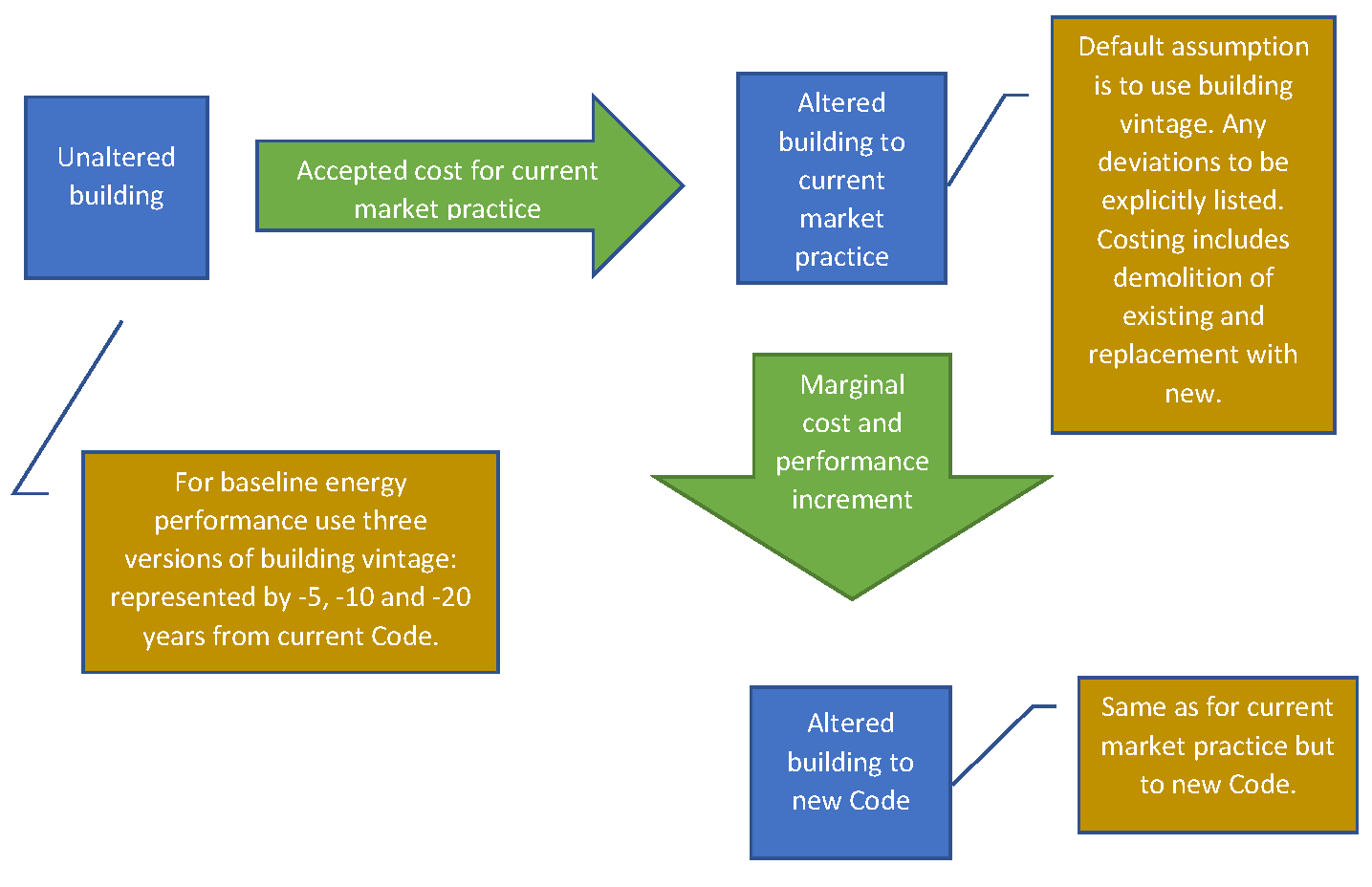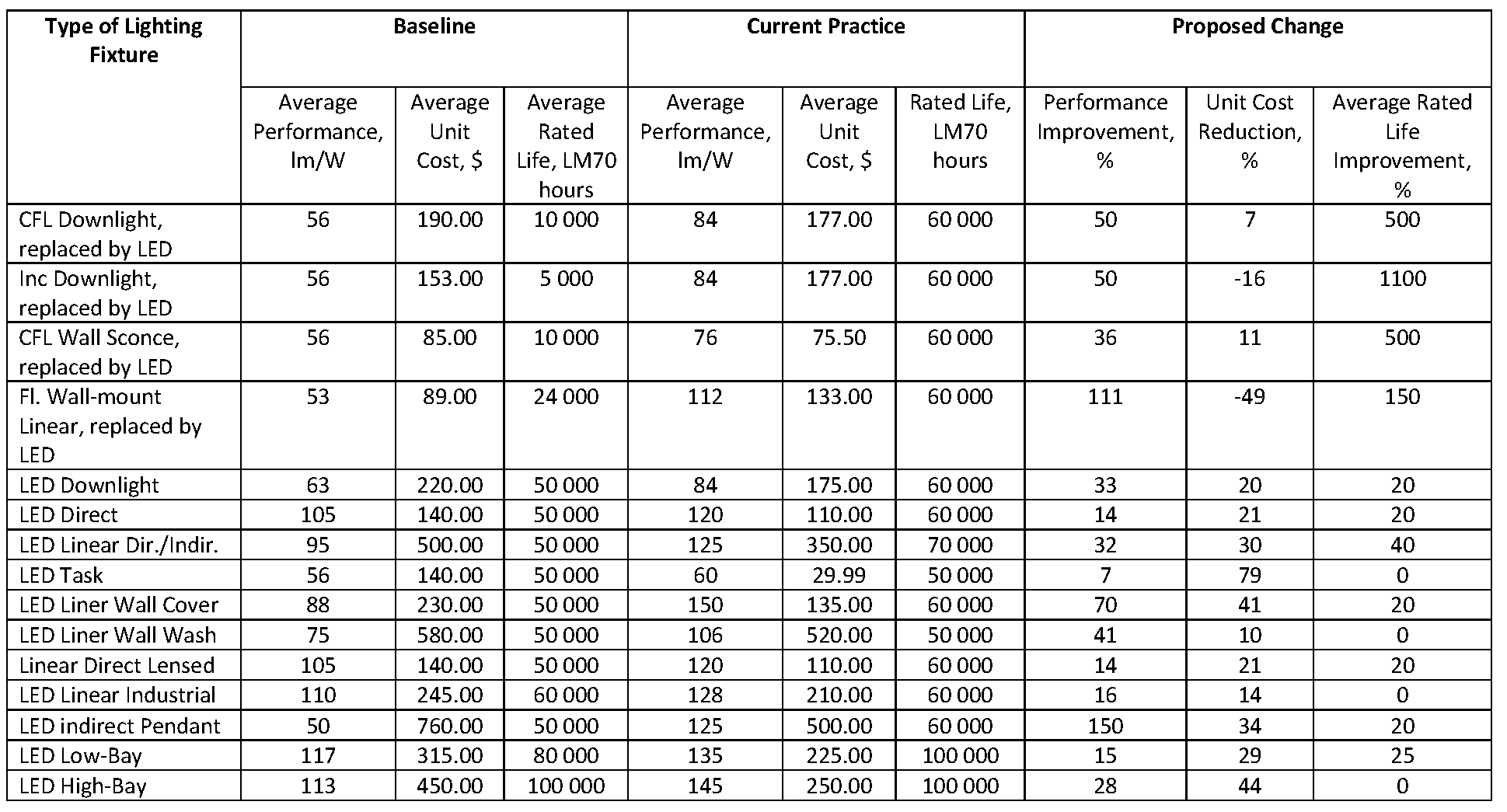General information
Problem
The alteration of lighting components and systems in commercial buildings is very common. However, this opportunity to make energy-efficiency improvements is not well leveraged, such as by adopting more efficient LED lighting technology and products or employing new lighting controls to dim or switch off lights when the space is not occupied.
These alteration options provide a good opportunity to upgrade lighting systems to current minimum Code requirements. However, since renovation works in existing buildings are typically more costly than when building new constructions, the lighting requirements of Part 4 of Division B of the NECB applicable to these upgrades must be adapted to maintain an acceptable level of cost-effectiveness.
Justification
With the advent of LED lighting technology and products in today’s marketplace, there are many opportunities to replace older lighting systems in existing buildings with these much more energy-efficient products as well as to employ new lighting control systems and schemes to manage more effectively the operation of lighting systems.
Examples include making better use of the daylight contribution and the ability to automatically turn off unnecessary lights to reduce the energy consumption of existing buildings. Due to the transformation of the lighting market to LED technology, the cost of LED lighting products has substantially reduced to make these products very competitive with older fluorescent lighting products.
This proposed change would align the threshold for interior lighting (2 000 W) and exterior lighting (10 luminaires) with those given in ANSI/ASHRAE/IES 90.1-2022, “Energy Standard for Sites and Buildings Except Low-Rise Residential Buildings (I-P Edition),” and Vancouver Building By-law 2019.
PROPOSED CHANGE
[13.4.] -- Lighting
[13.4.1.] -- General
[13.4.1.1.] ---Scope
[13.4.1.2.] ---Application
[13.4.2.] -- Compliance
[13.4.2.1.] ---Requirements
Impact analysis
The impact analysis guidelines for the alteration of existing buildings, as illustrated in Figure 1, require that the proposed changes be evaluated for several building vintages. The key metric of interest in the impact analysis is the marginal difference between the current market practice and the proposed change.

Figure 1. Impact analysis guidelines for the alteration of existing buildings
Since the prescriptive requirements for the alteration of existing buildings are triggered only when alterations are performed, the metric to evaluate the impact of the marginal cost and performance increment is defined as the comparison between the new prescriptive requirements and what would normally be done in the absence of such (i.e., current market practice).
For this analysis, four vintages of unaltered buildings were selected:
- Pre-1980
- 1980–2010
- NECB 2011
- NECB 2015
Current market practice is defined as complying with NECB 2017, and the proposed code is considered to be the NECB 2020.
To calculate the marginal energy increment, a model representing the vintage was created (see https://github.com/NREL/openstudio-standards/tree/master/lib/openstudio-standards/standards/necb). The lighting systems were then updated in the model to comply with the NECB 2017 requirements and the energy use intensity (EUI) calculated. The same process was followed for the NECB 2020 requirements. The marginal energy increment is the difference between these two EUIs. This process was repeated for all the vintages for 14 building archetypes in 32 locations across Canada; thus 1792 marginal energy increments were calculated. Summary results from the simulations are presented by region in Figures 2 and 3.

Figure 2. Marginal energy use intensity increment for various building archetypes and vintages in regions across Canada

Figure 3. Marginal percentage energy use intensity increment for various building archetypes and vintages in regions across Canada
As can be seen, the increment is positive in almost all cases (i.e., the proposed change represents a reduction in energy use at the building level). The exception is the hospital archetype, where energy use increases slightly (less than 1%). This result was also observed in previous studies and is due to the increase in lighting power density (LPD) requirements for hospitals given the increased illumination requirements.
For the remainder of the archetypes, the changes are positive for all vintages and broadly similar across regions. The impact is greatest for buildings that are sensitive to lighting loads, i.e., office and retail buildings (up to 4% improvement over the current market practice). For buildings with minimally regulated lighting loads (e.g., multi-unit residential buildings (MURBs)) or energy use that is dominated by other subsystems (e.g., quick-service restaurants), the impact is minimal. Overall, the energy analysis demonstrates that the proposed change is no worse than current practice (excluding hospitals) and in some cases represents an improvement in energy performance.
The change in total lighting energy end use is presented in Figure 4. Comparing the results for the NECB 2020 and the NECB 2017 vintages, energy use increases for hospitals, but decreases for all other archetypes.

Figure 4. Lighting end use energy consumption by archetype and vintage
Cost estimates are subject to high levels of uncertainty. The following section is based on a 2019 report by Quantum Lighting Inc. on the lighting costs associated with switching from the LPDs prescribed in the NECB 2017 to those in the NECB 2020.
The costs for different fixtures to be expected in the 16 archetypes considered in this analysis are presented in Table 1. The average unit cost is the per fixture cost. Both the “Baseline” and “Current” columns refer to the same type of lighting fixture but specifically to different products with different illuminance (i.e., average performance (lm/W)). In some cases, fixtures in the baseline column are FL/CFL and are upgraded to LED; in other cases, LEDs are already used in current practice and the cost difference reflects the use of newer products.
Table 1. Changes in Per Unit Costs for Commonly Used Fixture Types

Table 1 shows a cost savings instead of increase for the majority of the fixtures with the upgrades to NECB 2020 These findings, and the fact that the use of LED is already common practice for some spaces/archetypes, mean that the adherence to NECB 2020 would likely result in cost savings and a simple payback of 0 years.
Enforcement implications
The requirements for lighting in existing buildings subjected to alteration could be enforced by existing means and resources involved in the enforcement of the Part 4 requirements of the NECB.
Who is affected
Designers, specification writers, manufacturers, contractors, building owners and building officials.
OBJECTIVE-BASED ANALYSIS OF NEW OR CHANGED PROVISIONS
- Date modified:
